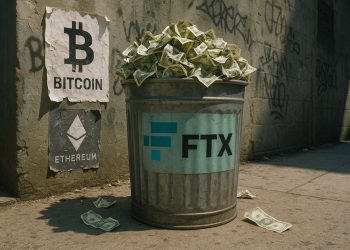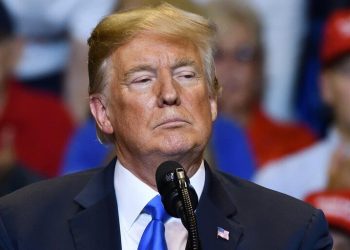The U.S. dollar has been a symbol of American power for decades. Of the $7.5 trillion in global currency transactions that take place each day, some 90 percent feature the dollar. The majority of central banks see it as the core of their reserves. Consumers run to it in times of stress. Businesses prefer it for trade invoicing, whether they are based in Milwaukee or Malaysia.
The dollar may not lose its globally dominant role anytime soon. After all, there isn’t an obvious alternative waiting in the wings. But it is suffering from a self-inflicted wound and the consequences are just starting to be felt around the world.
A trickle of selling began in mid-January as investors bought euros on the hopes that a new German government would loosen its purse strings. That trickle turned into a “sell America” torrent after President Trump unveiled shockingly large, broad-based tariffs on April 2, and followed that by stepping up his attacks on the Federal Reserve chair, Jerome Powell.
A search for new safe harbors began. In the week ending April 16, gold funds had their biggest inflows since 2007, while selling of U.S. bond funds was the highest recorded since late March 2020. Stock markets churned in ways not seen since either the pandemic or the 2008 financial crisis.
An uneasy stability has returned since the president paused most tariffs and seemed to back down from his threats to fire Mr. Powell. But damage has been done. This year, through April 25, the dollar has lost more than 8 percent in value versus the currencies of its major trading partners.
The White House has repeatedly stated a preference for a weaker dollar, which could boost manufacturing exports by making them relatively less expensive. That worked in the economy’s favor in the 2000s.
Unfortunately, what we are seeing today is nothing like that historical precedent. The way the Trump administration is pursuing its goals is unnerving investors and leaving them less certain about their U.S. assets. They are questioning not only how the trade war will affect global growth but also the strength of American institutions and the country’s reliability as a global partner.
The White House has overturned long-held assumptions on issues such as the future of Ukraine and the sovereignty of Greenland and Canada and just a few years after Mr. Trump touted his U.S.-Mexico-Canada trade deal as “the most modern, up-to-date and balanced trade agreement in the history of our country.”
The April meetings of the International Monetary Fund and the World Bank in Washington were filled with chatter about how America was acting like an emerging market (think Turkey). Some large foreign investors wondered if they might have to pay a fee to buy U.S. assets — an idea floated by the chairman of the Council of Economic Advisers, Stephen Miran — or whether the U.S. government might somehow prevent them from selling those assets when they wanted to.
Investment committees around the world, including at pension funds, endowments and central banks, will now decide whether to trim their U.S. investments. As of mid-2024, overseas investors held over $31 trillion in U.S. stocks and bonds. Large institutional investors tend to move slowly, so any shift would likely happen gradually. That said, it would still diminish the dollar’s dominance. Even small changes, say a cut of two percentage points from each equities and bonds, would total $1.24 trillion, much of which would require investors to sell dollars as they redeployed their capital. Any cuts would suggest less inbound investment in the future, too.
What will this weaker-dollar world feel like? There are some benefits, including how a depreciating currency would help American exports. Mr. Trump hopes that deals reached during the tariff pause will increase opportunities for American companies. And a softer dollar might help encourage tourism to the United States, which is showing signs of dropping. That would support millions of jobs.
It would also make foreign assets more attractive. Let’s say I buy a pied-à-terre in Paris (we can all dream). I have to sell my dollars to acquire some euros to complete the transaction. If the dollar weakens further against the euro, when I sell the apartment and bring my money home, I make a profit not just from any gains in my real estate but also through the exchange rate. A stronger euro means I get a larger number of dollars back.
Sadly, that’s not the end of the story, because a weaker dollar also introduces significant potential costs. It makes imported goods more expensive, most likely increasing prices and undermining household purchasing power. Procter & Gamble, in its latest quarterly earnings release, said it planned to raise prices on some of its products even though consumer demand has slowed. Imports, including raw materials, packaging and some finished goods, account for roughly 10 percent of all the P&G goods sold in the United States.
This puts the Fed in a tricky position as it navigates both its inflation and employment goals. Inflation remains above the central bank’s 2 percent target, and for now, the labor market is solid. That’s why the central bank has held interest rates steady at its recent meetings. But on the horizon is slower growth and potentially faster inflation.
Mr. Trump, focused on growth, has vocally pushed for rate cuts. So far, the Fed has demurred. It knows that with inflation expectations rising, a premature cut would risk its credibility, not to mention a bigger potential exodus from U.S. bonds.
The rest of the world is caught in the crossfire. Take Japan. Two weeks after Mr. Trump’s tariffs were announced, private Japanese investors sold more than $20 billion worth of foreign bonds. During the first week, U.S. Treasury bond yields surged, suggesting that American debt was among the assets the Japanese were selling.
Japanese investors who sell U.S. bonds will often then sell the dollars they receive to buy yen, which strengthens its value against the dollar. That happened this year, to the tune of a 9 percent gain. Unfortunately for Japan, its stock market is sensitive to exchange rates, given the primacy of exporters such as Sumitomo and Toyota. A stronger yen, in addition to tariffs, would undermine Japanese exports. The Nikkei index lost nearly 10 percent this year through April, despite being a Wall Street favorite.
Sentiment among large Japanese companies has been falling fast. The International Monetary Fund cut Japan’s 2025 gross domestic product growth forecast in April by half a percentage point, to 0.6 percent, given the expected drag on the economy from the trade war.
This dynamic is playing out across America’s largest trading partners. Even if the weaker dollar helps American exports, global demand for its goods is softening. The I.M.F.’s 2025 projections suggested global growth this year of 2.8 percent, half a percentage point lower than what it expected back in January.
There is a better version of a falling dollar. Between mid-2001 and mid-2008, the currency gradually lost 40 percent compared with its major peers. Americans, attracted by overseas investment opportunities, sold dollars to buy foreign equities and bonds. Strong global demand for American goods, coupled with a competitive currency, resulted in robust export growth.
The economic benefits from that weak-dollar period were not evenly distributed. Export companies thrived, but America still lost around three million manufacturing jobs, continuing an erosion seen for decades. Some of those losses came from outsourcing manufacturing, including to China — a major argument in today’s trade war. Another chunk came from the increased use of technology — a topic notably missing from policy conversations especially as advances in artificial intelligence threaten more job displacement.
History tells us that a softer dollar isn’t a panacea, and that it’s also important to understand why the currency is falling. The policy path being pursued today may result in some improved bilateral business opportunities. But those gains will be offset by damage, which will flow through to consumers and businesses, potentially for years to come, in the form of relatively higher prices and interest rates.
If America wants to help manufacturing and export workers, and also have a weak dollar, it should think hard about what policies can lift America and the rest of the world together. Let’s hope Treasury Secretary Scott Bessent will encourage his White House colleagues to act more in line with his recent remark in Washington when he said, “America First does not mean America alone.”
Rebecca Patterson is an economist and senior fellow at the Council on Foreign Relations who has held senior positions at JPMorgan Chase and Bridgewater Associates.
The Times is committed to publishing a diversity of letters to the editor. We’d like to hear what you think about this or any of our articles. Here are some tips. And here’s our email: letters@nytimes.com.
Follow the New York Times Opinion section on Facebook, Instagram, TikTok, Bluesky, WhatsApp and Threads.
#Opinion #Sad #World #Weak #U.S #Dollar




















